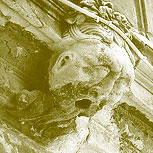 Thinking about the 'text' of things, other than text, I recently saw a documentary James McNeill Whistler's "Arrangement in Gray and Black No. 1: Portrait of the Artist's Mother." More commonly known as "Whistler's Mother".
Thinking about the 'text' of things, other than text, I recently saw a documentary James McNeill Whistler's "Arrangement in Gray and Black No. 1: Portrait of the Artist's Mother." More commonly known as "Whistler's Mother".
I can't, with any honesty say, that I was terribly attracted to this painting before watching the documentary, but after, I looked at it differently, and I found it much more intriguing. I had always imagined the work had been painted in the US, and it is only when I found out that it had been painted in London, did the context of the picture and its remarkable stark simplicity (compare it with the lush, Pre-raphaelite style of Dante Gabriel Rossetti who was a friend and contemporary of Whistler or the sentimentalism of Millais). The lack of colour, or props in the painting is in direct opposition to everything being painted by his contemporaries.
In a way, it's closer to the Problem Picture genre of the late Victorian period, although there is no obvious narrative, because it does present a puzzle. For a start, look at the title: the utter lack of sentimentality - he names his mother after he lists the colours. Then there is the total lack of engagement with the subject, who is painted in side-view, staring into the darkness at the left-hand side of the painting.
Barthes says that the author's life, and the events surrounding the making of the work don't matter but, if this painting is anything, it is proof that he is wrong. Because without the accompanying information, there is no understanding this piece of art.
Anna McNeill Whistler (his mother) was widow and a devoutly religious woman, puritanical and utterly self-reliant by all accounts (Norris). There's some evidence that she did not much approve of her son's decadent lifestyle in London. When she moved there, to escape the Civil War, she lived with her son, having control of his house in every aspect, other than his studio.
Her portrait was originally meant to be a standing one, but she was ill and couldn't support the pose after the first three days, so Whistler had her sit, her feet up on a footstool. She wrote a letter about the experience of sitting for the portrait and remarked that to pass the time, she prayed for her son. (Whistler).
This information caused me to see the painting as a sort of recursive, or mise en abyme piece. The artist's feelings for his mother were clearly problematic. He paints her, not in his world, but in her own - which brooks no extravagance and little decoration, which is entirely internal. And yet, he is in her mind constantly, throughout the painting.
Not an obvious, narrative puzzle, but an internal, human one of love and the boundaries of tolerance.
Musing on the Text of Whistler's Mother
Saturday, May 17, 2008Posted by Madeleine Morris at 10:37 PM
Subscribe to:
Post Comments (Atom)

0 comments:
Post a Comment